Leadership Report: Challenges and Strategies in Software Industry
VerifiedAdded on 2022/08/26
|6
|1615
|17
Report
AI Summary
This report examines the critical role of leadership within the software industry, emphasizing its impact on project management, innovation, and overall organizational success. It highlights the importance of leadership skills such as self-awareness, motivation, and patience, as well as the ability to manage critical situations and foster a positive work environment. The report discusses various leadership styles, including transformational and servant leadership, and their benefits in managing business strategies and driving technological advancements. It also analyzes challenges faced by leaders in the software industry and provides insights into effective strategies for overcoming them, such as change management and performance management. The conclusion underscores the necessity of strong leadership for improving business processes and achieving project success in the software sector.
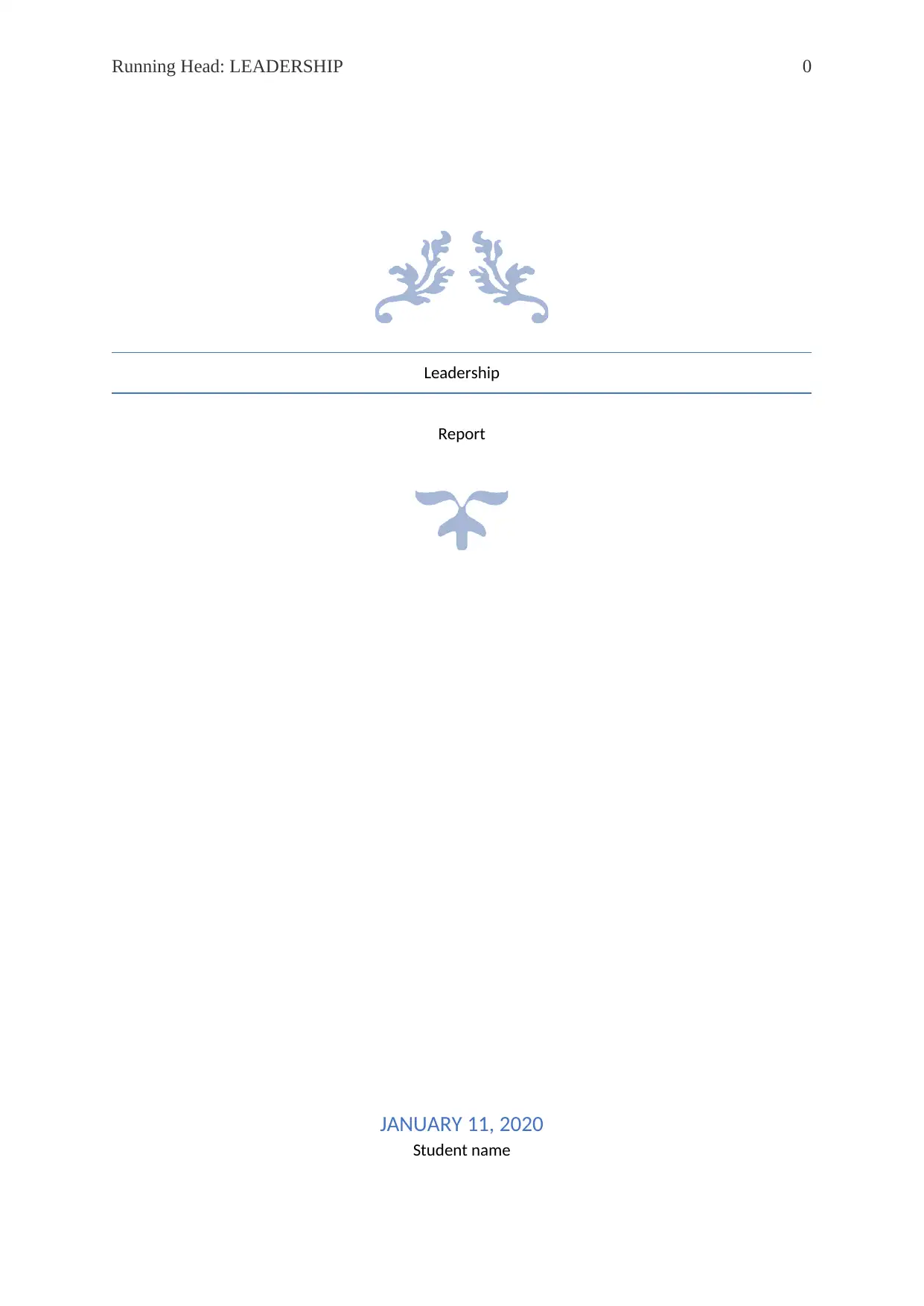
Running Head: LEADERSHIP 0
Leadership
Report
JANUARY 11, 2020
Student name
Leadership
Report
JANUARY 11, 2020
Student name
Paraphrase This Document
Need a fresh take? Get an instant paraphrase of this document with our AI Paraphraser
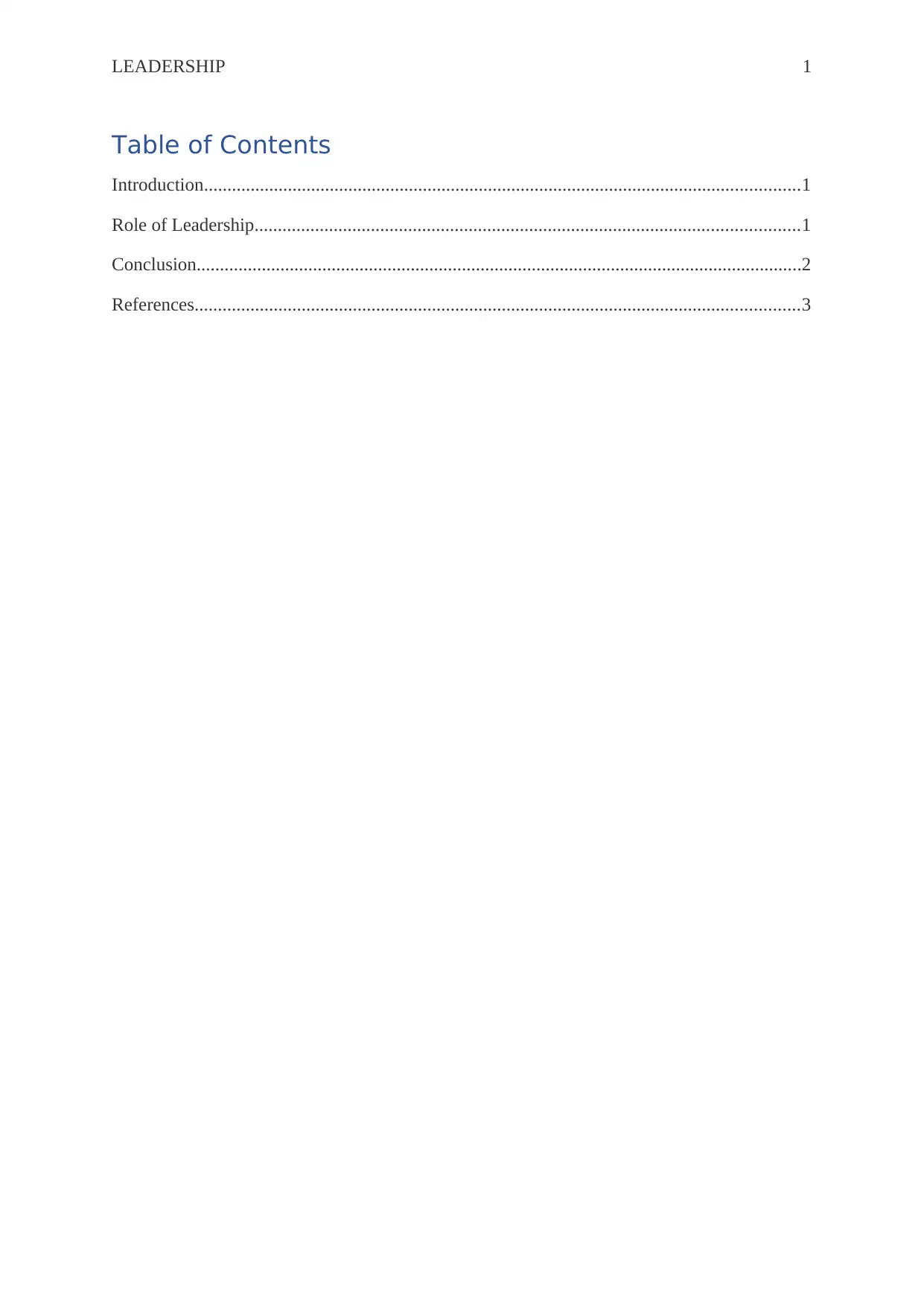
LEADERSHIP 1
Table of Contents
Introduction................................................................................................................................1
Role of Leadership.....................................................................................................................1
Conclusion..................................................................................................................................2
References..................................................................................................................................3
Table of Contents
Introduction................................................................................................................................1
Role of Leadership.....................................................................................................................1
Conclusion..................................................................................................................................2
References..................................................................................................................................3
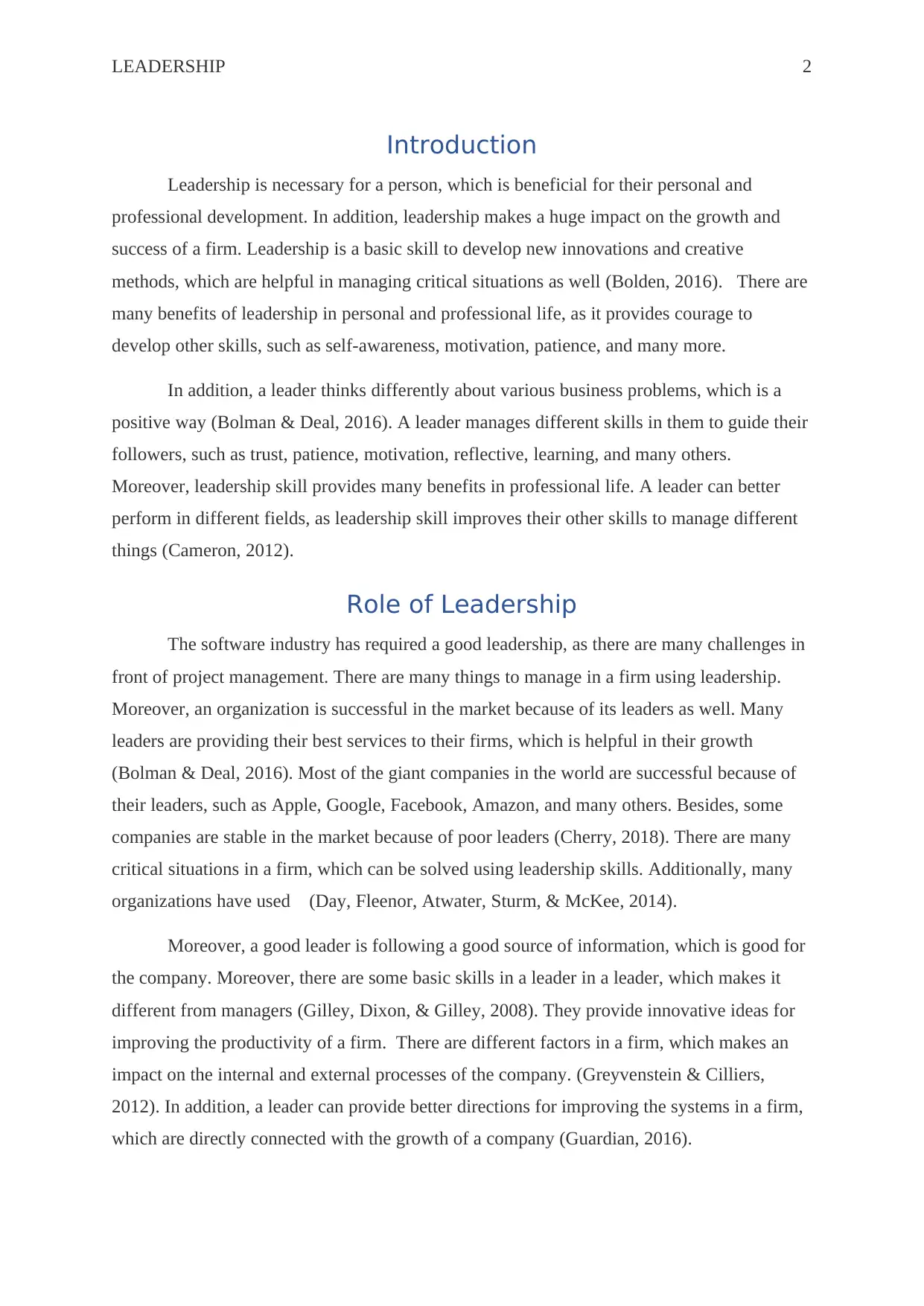
LEADERSHIP 2
Introduction
Leadership is necessary for a person, which is beneficial for their personal and
professional development. In addition, leadership makes a huge impact on the growth and
success of a firm. Leadership is a basic skill to develop new innovations and creative
methods, which are helpful in managing critical situations as well (Bolden, 2016). There are
many benefits of leadership in personal and professional life, as it provides courage to
develop other skills, such as self-awareness, motivation, patience, and many more.
In addition, a leader thinks differently about various business problems, which is a
positive way (Bolman & Deal, 2016). A leader manages different skills in them to guide their
followers, such as trust, patience, motivation, reflective, learning, and many others.
Moreover, leadership skill provides many benefits in professional life. A leader can better
perform in different fields, as leadership skill improves their other skills to manage different
things (Cameron, 2012).
Role of Leadership
The software industry has required a good leadership, as there are many challenges in
front of project management. There are many things to manage in a firm using leadership.
Moreover, an organization is successful in the market because of its leaders as well. Many
leaders are providing their best services to their firms, which is helpful in their growth
(Bolman & Deal, 2016). Most of the giant companies in the world are successful because of
their leaders, such as Apple, Google, Facebook, Amazon, and many others. Besides, some
companies are stable in the market because of poor leaders (Cherry, 2018). There are many
critical situations in a firm, which can be solved using leadership skills. Additionally, many
organizations have used (Day, Fleenor, Atwater, Sturm, & McKee, 2014).
Moreover, a good leader is following a good source of information, which is good for
the company. Moreover, there are some basic skills in a leader in a leader, which makes it
different from managers (Gilley, Dixon, & Gilley, 2008). They provide innovative ideas for
improving the productivity of a firm. There are different factors in a firm, which makes an
impact on the internal and external processes of the company. (Greyvenstein & Cilliers,
2012). In addition, a leader can provide better directions for improving the systems in a firm,
which are directly connected with the growth of a company (Guardian, 2016).
Introduction
Leadership is necessary for a person, which is beneficial for their personal and
professional development. In addition, leadership makes a huge impact on the growth and
success of a firm. Leadership is a basic skill to develop new innovations and creative
methods, which are helpful in managing critical situations as well (Bolden, 2016). There are
many benefits of leadership in personal and professional life, as it provides courage to
develop other skills, such as self-awareness, motivation, patience, and many more.
In addition, a leader thinks differently about various business problems, which is a
positive way (Bolman & Deal, 2016). A leader manages different skills in them to guide their
followers, such as trust, patience, motivation, reflective, learning, and many others.
Moreover, leadership skill provides many benefits in professional life. A leader can better
perform in different fields, as leadership skill improves their other skills to manage different
things (Cameron, 2012).
Role of Leadership
The software industry has required a good leadership, as there are many challenges in
front of project management. There are many things to manage in a firm using leadership.
Moreover, an organization is successful in the market because of its leaders as well. Many
leaders are providing their best services to their firms, which is helpful in their growth
(Bolman & Deal, 2016). Most of the giant companies in the world are successful because of
their leaders, such as Apple, Google, Facebook, Amazon, and many others. Besides, some
companies are stable in the market because of poor leaders (Cherry, 2018). There are many
critical situations in a firm, which can be solved using leadership skills. Additionally, many
organizations have used (Day, Fleenor, Atwater, Sturm, & McKee, 2014).
Moreover, a good leader is following a good source of information, which is good for
the company. Moreover, there are some basic skills in a leader in a leader, which makes it
different from managers (Gilley, Dixon, & Gilley, 2008). They provide innovative ideas for
improving the productivity of a firm. There are different factors in a firm, which makes an
impact on the internal and external processes of the company. (Greyvenstein & Cilliers,
2012). In addition, a leader can provide better directions for improving the systems in a firm,
which are directly connected with the growth of a company (Guardian, 2016).
⊘ This is a preview!⊘
Do you want full access?
Subscribe today to unlock all pages.

Trusted by 1+ million students worldwide
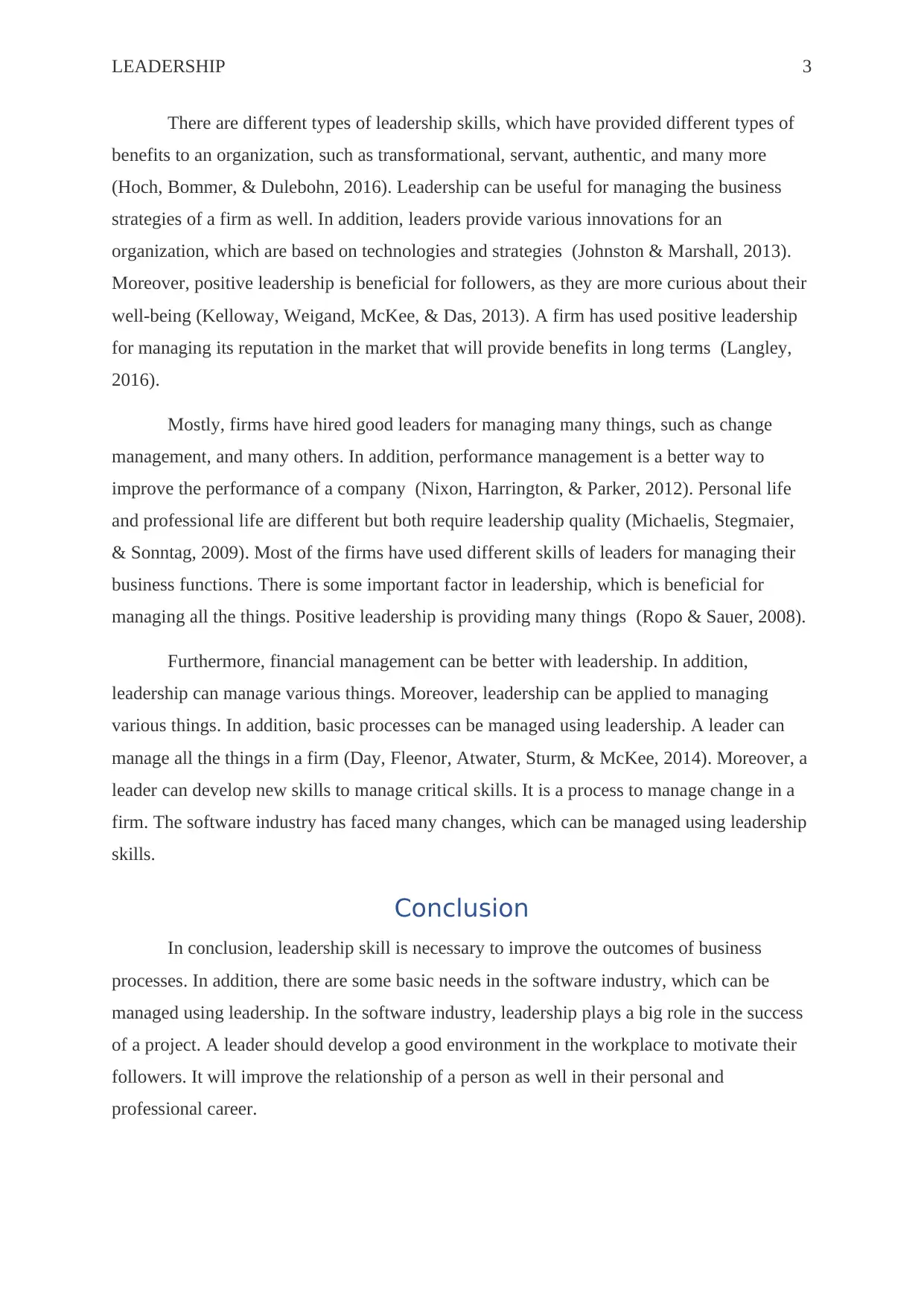
LEADERSHIP 3
There are different types of leadership skills, which have provided different types of
benefits to an organization, such as transformational, servant, authentic, and many more
(Hoch, Bommer, & Dulebohn, 2016). Leadership can be useful for managing the business
strategies of a firm as well. In addition, leaders provide various innovations for an
organization, which are based on technologies and strategies (Johnston & Marshall, 2013).
Moreover, positive leadership is beneficial for followers, as they are more curious about their
well-being (Kelloway, Weigand, McKee, & Das, 2013). A firm has used positive leadership
for managing its reputation in the market that will provide benefits in long terms (Langley,
2016).
Mostly, firms have hired good leaders for managing many things, such as change
management, and many others. In addition, performance management is a better way to
improve the performance of a company (Nixon, Harrington, & Parker, 2012). Personal life
and professional life are different but both require leadership quality (Michaelis, Stegmaier,
& Sonntag, 2009). Most of the firms have used different skills of leaders for managing their
business functions. There is some important factor in leadership, which is beneficial for
managing all the things. Positive leadership is providing many things (Ropo & Sauer, 2008).
Furthermore, financial management can be better with leadership. In addition,
leadership can manage various things. Moreover, leadership can be applied to managing
various things. In addition, basic processes can be managed using leadership. A leader can
manage all the things in a firm (Day, Fleenor, Atwater, Sturm, & McKee, 2014). Moreover, a
leader can develop new skills to manage critical skills. It is a process to manage change in a
firm. The software industry has faced many changes, which can be managed using leadership
skills.
Conclusion
In conclusion, leadership skill is necessary to improve the outcomes of business
processes. In addition, there are some basic needs in the software industry, which can be
managed using leadership. In the software industry, leadership plays a big role in the success
of a project. A leader should develop a good environment in the workplace to motivate their
followers. It will improve the relationship of a person as well in their personal and
professional career.
There are different types of leadership skills, which have provided different types of
benefits to an organization, such as transformational, servant, authentic, and many more
(Hoch, Bommer, & Dulebohn, 2016). Leadership can be useful for managing the business
strategies of a firm as well. In addition, leaders provide various innovations for an
organization, which are based on technologies and strategies (Johnston & Marshall, 2013).
Moreover, positive leadership is beneficial for followers, as they are more curious about their
well-being (Kelloway, Weigand, McKee, & Das, 2013). A firm has used positive leadership
for managing its reputation in the market that will provide benefits in long terms (Langley,
2016).
Mostly, firms have hired good leaders for managing many things, such as change
management, and many others. In addition, performance management is a better way to
improve the performance of a company (Nixon, Harrington, & Parker, 2012). Personal life
and professional life are different but both require leadership quality (Michaelis, Stegmaier,
& Sonntag, 2009). Most of the firms have used different skills of leaders for managing their
business functions. There is some important factor in leadership, which is beneficial for
managing all the things. Positive leadership is providing many things (Ropo & Sauer, 2008).
Furthermore, financial management can be better with leadership. In addition,
leadership can manage various things. Moreover, leadership can be applied to managing
various things. In addition, basic processes can be managed using leadership. A leader can
manage all the things in a firm (Day, Fleenor, Atwater, Sturm, & McKee, 2014). Moreover, a
leader can develop new skills to manage critical skills. It is a process to manage change in a
firm. The software industry has faced many changes, which can be managed using leadership
skills.
Conclusion
In conclusion, leadership skill is necessary to improve the outcomes of business
processes. In addition, there are some basic needs in the software industry, which can be
managed using leadership. In the software industry, leadership plays a big role in the success
of a project. A leader should develop a good environment in the workplace to motivate their
followers. It will improve the relationship of a person as well in their personal and
professional career.
Paraphrase This Document
Need a fresh take? Get an instant paraphrase of this document with our AI Paraphraser
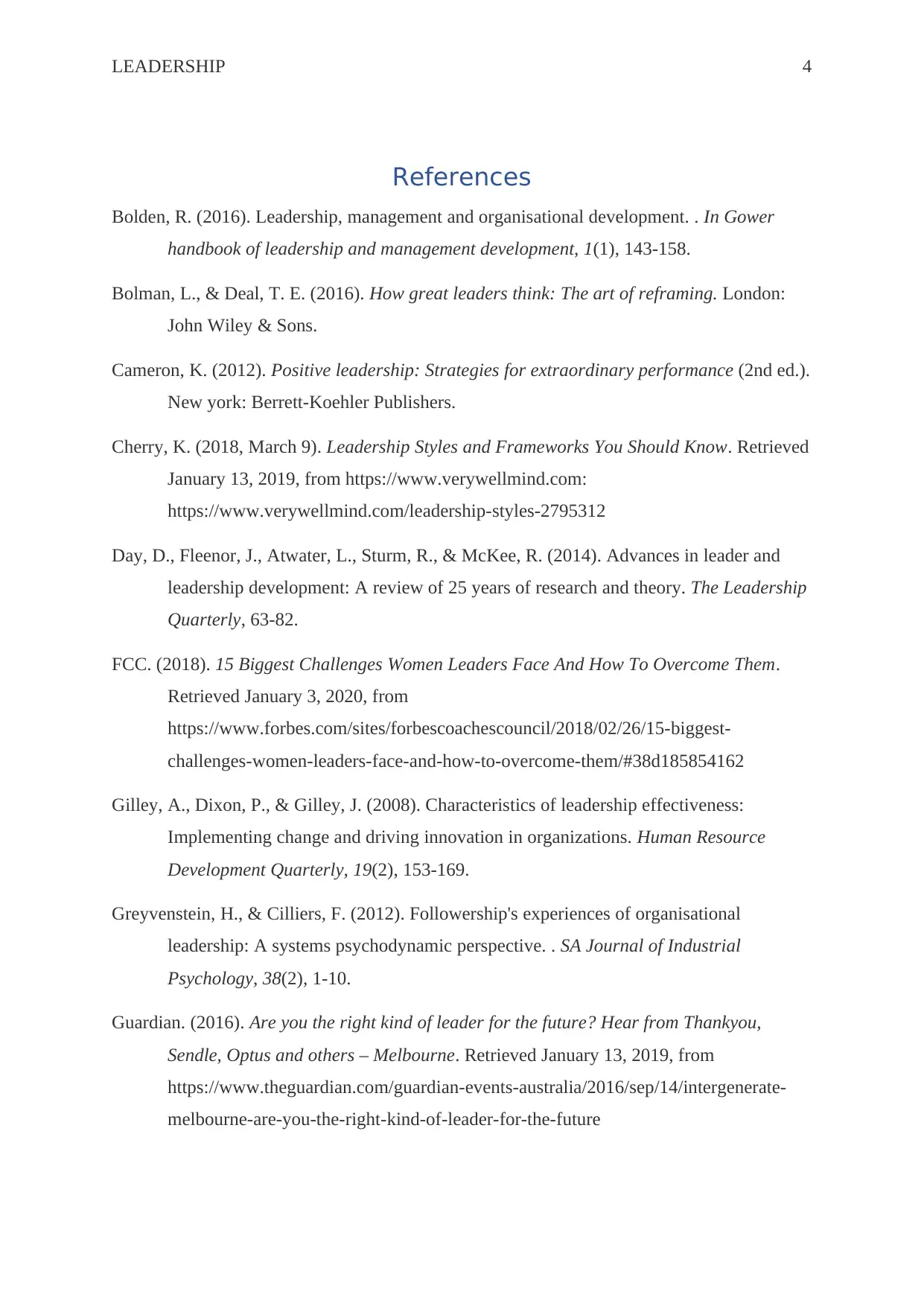
LEADERSHIP 4
References
Bolden, R. (2016). Leadership, management and organisational development. . In Gower
handbook of leadership and management development, 1(1), 143-158.
Bolman, L., & Deal, T. E. (2016). How great leaders think: The art of reframing. London:
John Wiley & Sons.
Cameron, K. (2012). Positive leadership: Strategies for extraordinary performance (2nd ed.).
New york: Berrett-Koehler Publishers.
Cherry, K. (2018, March 9). Leadership Styles and Frameworks You Should Know. Retrieved
January 13, 2019, from https://www.verywellmind.com:
https://www.verywellmind.com/leadership-styles-2795312
Day, D., Fleenor, J., Atwater, L., Sturm, R., & McKee, R. (2014). Advances in leader and
leadership development: A review of 25 years of research and theory. The Leadership
Quarterly, 63-82.
FCC. (2018). 15 Biggest Challenges Women Leaders Face And How To Overcome Them.
Retrieved January 3, 2020, from
https://www.forbes.com/sites/forbescoachescouncil/2018/02/26/15-biggest-
challenges-women-leaders-face-and-how-to-overcome-them/#38d185854162
Gilley, A., Dixon, P., & Gilley, J. (2008). Characteristics of leadership effectiveness:
Implementing change and driving innovation in organizations. Human Resource
Development Quarterly, 19(2), 153-169.
Greyvenstein, H., & Cilliers, F. (2012). Followership's experiences of organisational
leadership: A systems psychodynamic perspective. . SA Journal of Industrial
Psychology, 38(2), 1-10.
Guardian. (2016). Are you the right kind of leader for the future? Hear from Thankyou,
Sendle, Optus and others – Melbourne. Retrieved January 13, 2019, from
https://www.theguardian.com/guardian-events-australia/2016/sep/14/intergenerate-
melbourne-are-you-the-right-kind-of-leader-for-the-future
References
Bolden, R. (2016). Leadership, management and organisational development. . In Gower
handbook of leadership and management development, 1(1), 143-158.
Bolman, L., & Deal, T. E. (2016). How great leaders think: The art of reframing. London:
John Wiley & Sons.
Cameron, K. (2012). Positive leadership: Strategies for extraordinary performance (2nd ed.).
New york: Berrett-Koehler Publishers.
Cherry, K. (2018, March 9). Leadership Styles and Frameworks You Should Know. Retrieved
January 13, 2019, from https://www.verywellmind.com:
https://www.verywellmind.com/leadership-styles-2795312
Day, D., Fleenor, J., Atwater, L., Sturm, R., & McKee, R. (2014). Advances in leader and
leadership development: A review of 25 years of research and theory. The Leadership
Quarterly, 63-82.
FCC. (2018). 15 Biggest Challenges Women Leaders Face And How To Overcome Them.
Retrieved January 3, 2020, from
https://www.forbes.com/sites/forbescoachescouncil/2018/02/26/15-biggest-
challenges-women-leaders-face-and-how-to-overcome-them/#38d185854162
Gilley, A., Dixon, P., & Gilley, J. (2008). Characteristics of leadership effectiveness:
Implementing change and driving innovation in organizations. Human Resource
Development Quarterly, 19(2), 153-169.
Greyvenstein, H., & Cilliers, F. (2012). Followership's experiences of organisational
leadership: A systems psychodynamic perspective. . SA Journal of Industrial
Psychology, 38(2), 1-10.
Guardian. (2016). Are you the right kind of leader for the future? Hear from Thankyou,
Sendle, Optus and others – Melbourne. Retrieved January 13, 2019, from
https://www.theguardian.com/guardian-events-australia/2016/sep/14/intergenerate-
melbourne-are-you-the-right-kind-of-leader-for-the-future
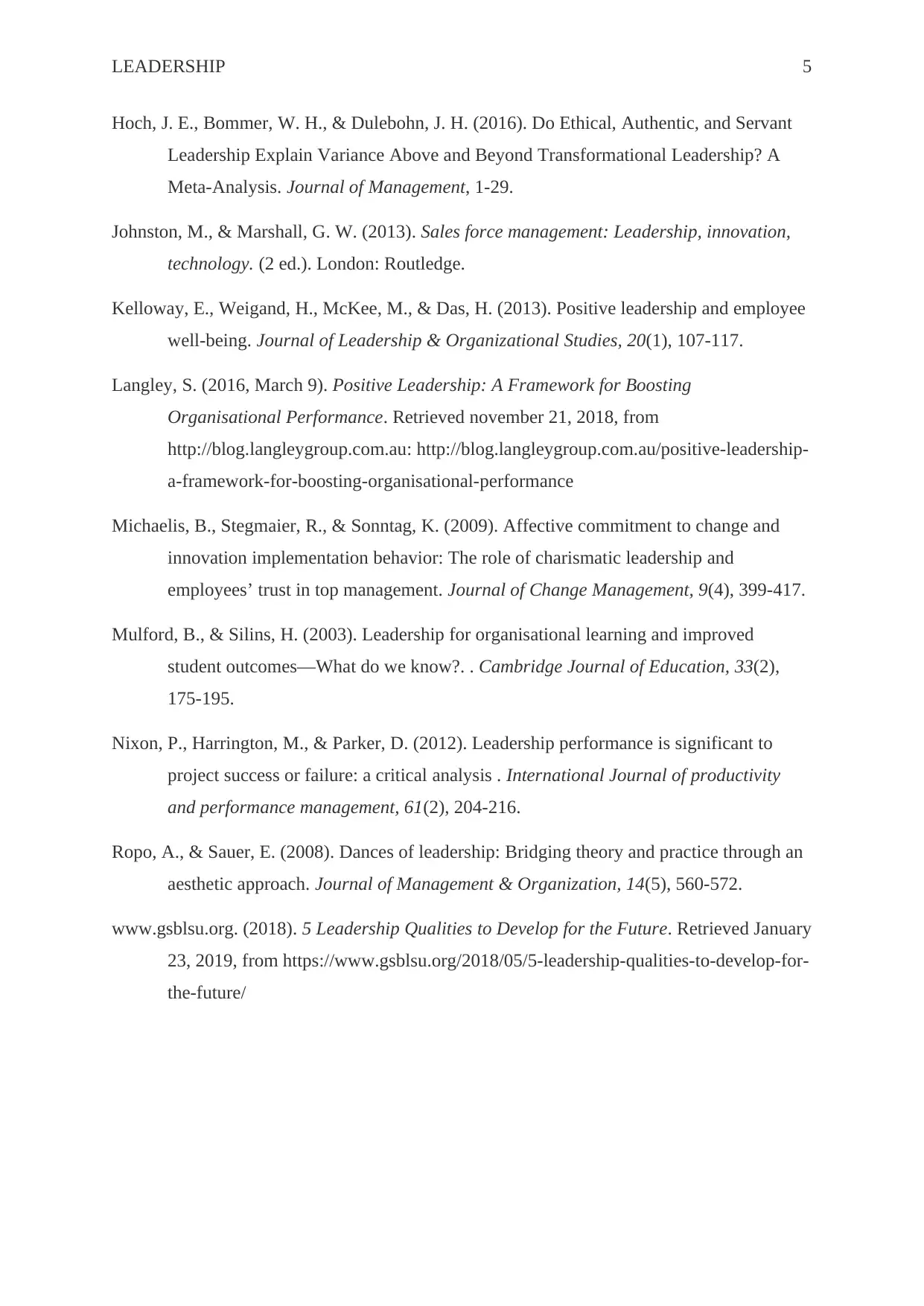
LEADERSHIP 5
Hoch, J. E., Bommer, W. H., & Dulebohn, J. H. (2016). Do Ethical, Authentic, and Servant
Leadership Explain Variance Above and Beyond Transformational Leadership? A
Meta-Analysis. Journal of Management, 1-29.
Johnston, M., & Marshall, G. W. (2013). Sales force management: Leadership, innovation,
technology. (2 ed.). London: Routledge.
Kelloway, E., Weigand, H., McKee, M., & Das, H. (2013). Positive leadership and employee
well-being. Journal of Leadership & Organizational Studies, 20(1), 107-117.
Langley, S. (2016, March 9). Positive Leadership: A Framework for Boosting
Organisational Performance. Retrieved november 21, 2018, from
http://blog.langleygroup.com.au: http://blog.langleygroup.com.au/positive-leadership-
a-framework-for-boosting-organisational-performance
Michaelis, B., Stegmaier, R., & Sonntag, K. (2009). Affective commitment to change and
innovation implementation behavior: The role of charismatic leadership and
employees’ trust in top management. Journal of Change Management, 9(4), 399-417.
Mulford, B., & Silins, H. (2003). Leadership for organisational learning and improved
student outcomes—What do we know?. . Cambridge Journal of Education, 33(2),
175-195.
Nixon, P., Harrington, M., & Parker, D. (2012). Leadership performance is significant to
project success or failure: a critical analysis . International Journal of productivity
and performance management, 61(2), 204-216.
Ropo, A., & Sauer, E. (2008). Dances of leadership: Bridging theory and practice through an
aesthetic approach. Journal of Management & Organization, 14(5), 560-572.
www.gsblsu.org. (2018). 5 Leadership Qualities to Develop for the Future. Retrieved January
23, 2019, from https://www.gsblsu.org/2018/05/5-leadership-qualities-to-develop-for-
the-future/
Hoch, J. E., Bommer, W. H., & Dulebohn, J. H. (2016). Do Ethical, Authentic, and Servant
Leadership Explain Variance Above and Beyond Transformational Leadership? A
Meta-Analysis. Journal of Management, 1-29.
Johnston, M., & Marshall, G. W. (2013). Sales force management: Leadership, innovation,
technology. (2 ed.). London: Routledge.
Kelloway, E., Weigand, H., McKee, M., & Das, H. (2013). Positive leadership and employee
well-being. Journal of Leadership & Organizational Studies, 20(1), 107-117.
Langley, S. (2016, March 9). Positive Leadership: A Framework for Boosting
Organisational Performance. Retrieved november 21, 2018, from
http://blog.langleygroup.com.au: http://blog.langleygroup.com.au/positive-leadership-
a-framework-for-boosting-organisational-performance
Michaelis, B., Stegmaier, R., & Sonntag, K. (2009). Affective commitment to change and
innovation implementation behavior: The role of charismatic leadership and
employees’ trust in top management. Journal of Change Management, 9(4), 399-417.
Mulford, B., & Silins, H. (2003). Leadership for organisational learning and improved
student outcomes—What do we know?. . Cambridge Journal of Education, 33(2),
175-195.
Nixon, P., Harrington, M., & Parker, D. (2012). Leadership performance is significant to
project success or failure: a critical analysis . International Journal of productivity
and performance management, 61(2), 204-216.
Ropo, A., & Sauer, E. (2008). Dances of leadership: Bridging theory and practice through an
aesthetic approach. Journal of Management & Organization, 14(5), 560-572.
www.gsblsu.org. (2018). 5 Leadership Qualities to Develop for the Future. Retrieved January
23, 2019, from https://www.gsblsu.org/2018/05/5-leadership-qualities-to-develop-for-
the-future/
⊘ This is a preview!⊘
Do you want full access?
Subscribe today to unlock all pages.

Trusted by 1+ million students worldwide
1 out of 6
Related Documents
Your All-in-One AI-Powered Toolkit for Academic Success.
+13062052269
info@desklib.com
Available 24*7 on WhatsApp / Email
![[object Object]](/_next/static/media/star-bottom.7253800d.svg)
Unlock your academic potential
Copyright © 2020–2025 A2Z Services. All Rights Reserved. Developed and managed by ZUCOL.





